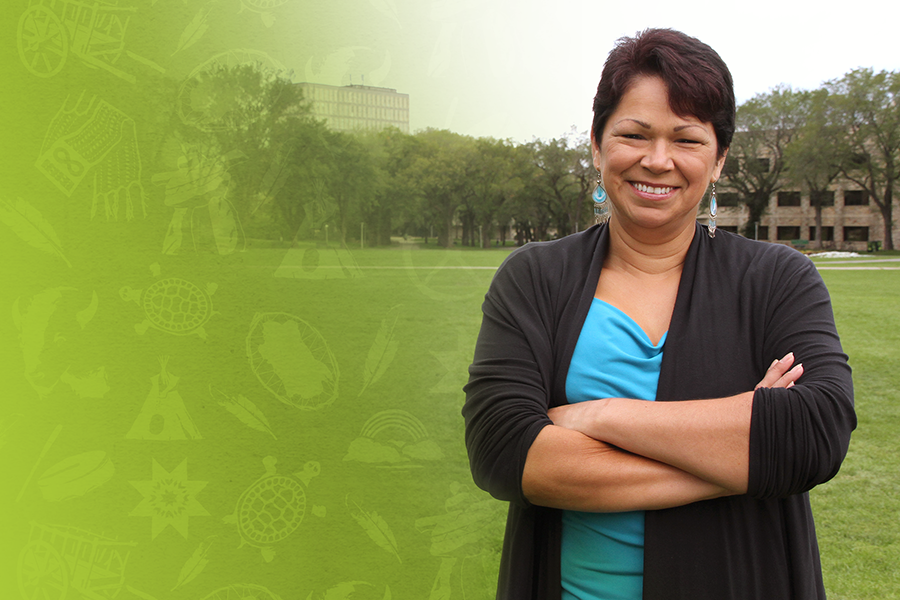
Creating an inclusive and diverse campus
Her son, about six years old at the time, told her he didn’t want to be brown anymore.
By Kris FosterIt was during that car ride back from Debden, Saskatchewan, when Elizabeth Duret knew she needed to do all she could to address negative stereotypes regarding Aboriginal people.
"For my son at that age to think that it's not okay to be who he is, was devastating," said Duret, inclusion and diversity consultant at the U of S. "Children aren't born racist; it is a behavior that they learn from friends, parents and media. It was at this pivotal moment that I knew I wanted to be an advocate for these issues."
As a Métis mother of two, Duret knows first-hand the judgments that Aboriginal people encounter. So when she got a phone call offering a new position at the U of S dedicated to supporting a diverse workforce, she accepted the challenge without hesitation.
The endgame for Duret, who started this new position in April, is to increase the diversity of the U of S workforce through recruitment and hiring practices with a strategic focus on Aboriginal people.
With a background as a probation officer, human resource professional and life skills coach, Duret has seen inequity in the form of underrepresentation in the work force and overrepresentation in the correctional system.
"Historically, the systems have negative biases and stereotypes attached to them," she explained. "There are systemic barriers because of social constructs. We need to address issues that prevent marginalized people from entering the workforce."
Because Aboriginal engagement has been a strategic priority at the U of S for some time, Duret said she is "coming into a rich opportunity. We are ready to engage in the process, all that is required is guidance, tools and a focused plan."
But there is still a lot to do and the enormity of the task is not lost on Duret. At the top of her mind is the significant gap between Aboriginal representation on the U of S workforce—a figure that is currently 2.6 per cent—and the provincial target of 12.2 per cent set by the Saskatchewan Human Rights Commission.
While Duret stressed that "no one wants to be hired just because the university is trying to reach a number," she said there are some relatively simple steps that will help make the university an employer of choice. She suggested that those involved in the hiring process attend cultural events and actively promote the U of S as an employer of choice; posting jobs in Aboriginal publications that reach Aboriginal communities; and including language in all hiring advertisements stating that the university values diversity and that Aboriginal engagement is a priority.
Duret said she and her human resources team are excited about how they can search out opportunities that will "help make the university the best place for Aboriginal people in Saskatchewan and Canada to work."
Some of the other initiatives being pursued include analyzing skill and experience requirements for positions, creating interview questions that highlight diversity, and addressing systemic stereotypes and barriers in hiring and retention practices. To that end, Duret's first priority is to create a safe environment on campus. "We need to create space to talk about stereotypes and biases. We all have them; I have my own. To face them you need to be honest with yourself. It's not about blame or guilt, but about self-reflection and awareness."
To help faculty and staff better understand biases, Duret holds workshops that tackle common stereotypes on everything from farmers, ex-cons and overweight people to Aboriginal people, gender and sexually diverse individuals, and people with learning disabilities and mental health issues.
"We explore stereotypes and how they play out in our work and personal life. We question where they come from and how they can be broken down," she said. "Someone can be ignorant only one time because once you are aware of your biases, you make the unconscious conscious. This knowledge is powerful and can create a change in attitude towards diversity."
It is a long road ahead, but Duret already has a picture of success in mind.
"We will know we are successful when we see increased recruitment, retention and success of Aboriginal students alongside the successful recruitment, retention and advancement of staff and faculty. I believe there is a strong correlation between the success of Aboriginal students and the presence of Aboriginal faculty and staff."

